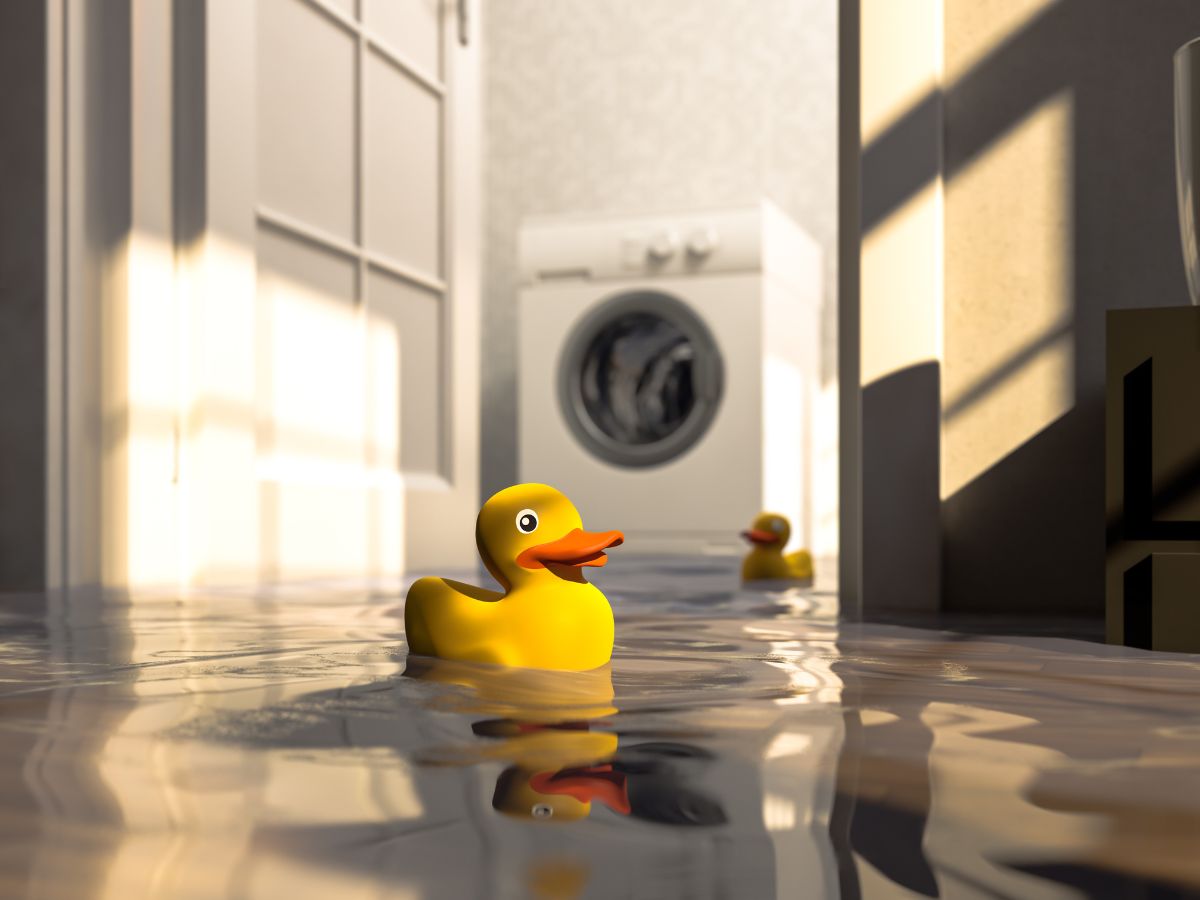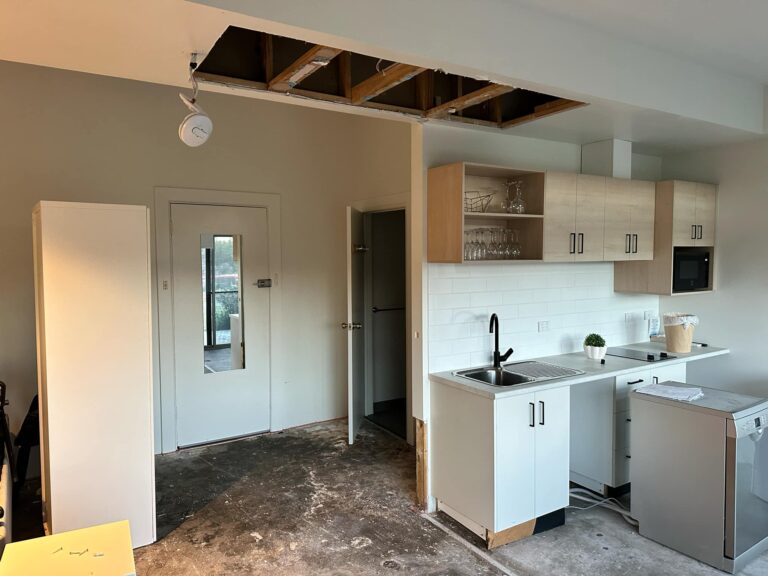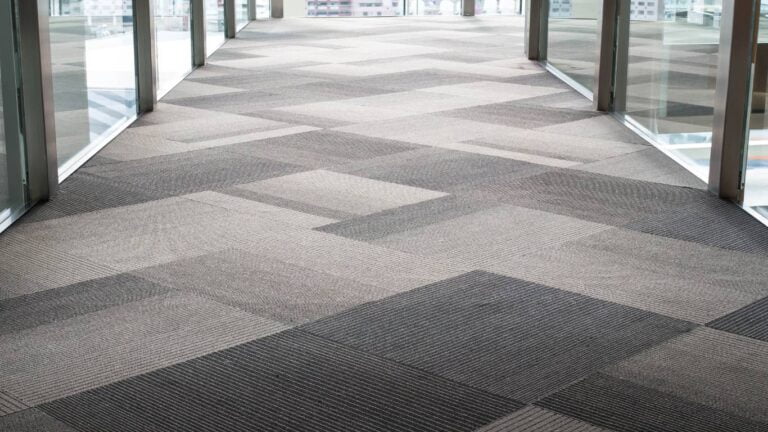Battling the musty stench of a wet carpet can be a frustrating endeavour. The key to successfully eliminating that lingering dampness lies in understanding the underlying causes and the most effective remedies. Whether it’s from accidental spills, pet mishaps, or the aftermath of a flood, knowing how to get rid of wet carpet smell not only improves the air quality of your home but also extends the life of your carpet. This article guides you through a comprehensive approach, from early detection and immediate actions to deep cleaning techniques and preventative maintenance. With these strategies, you’ll be equipped to tackle any nasty odours and restore the freshness of your living space.
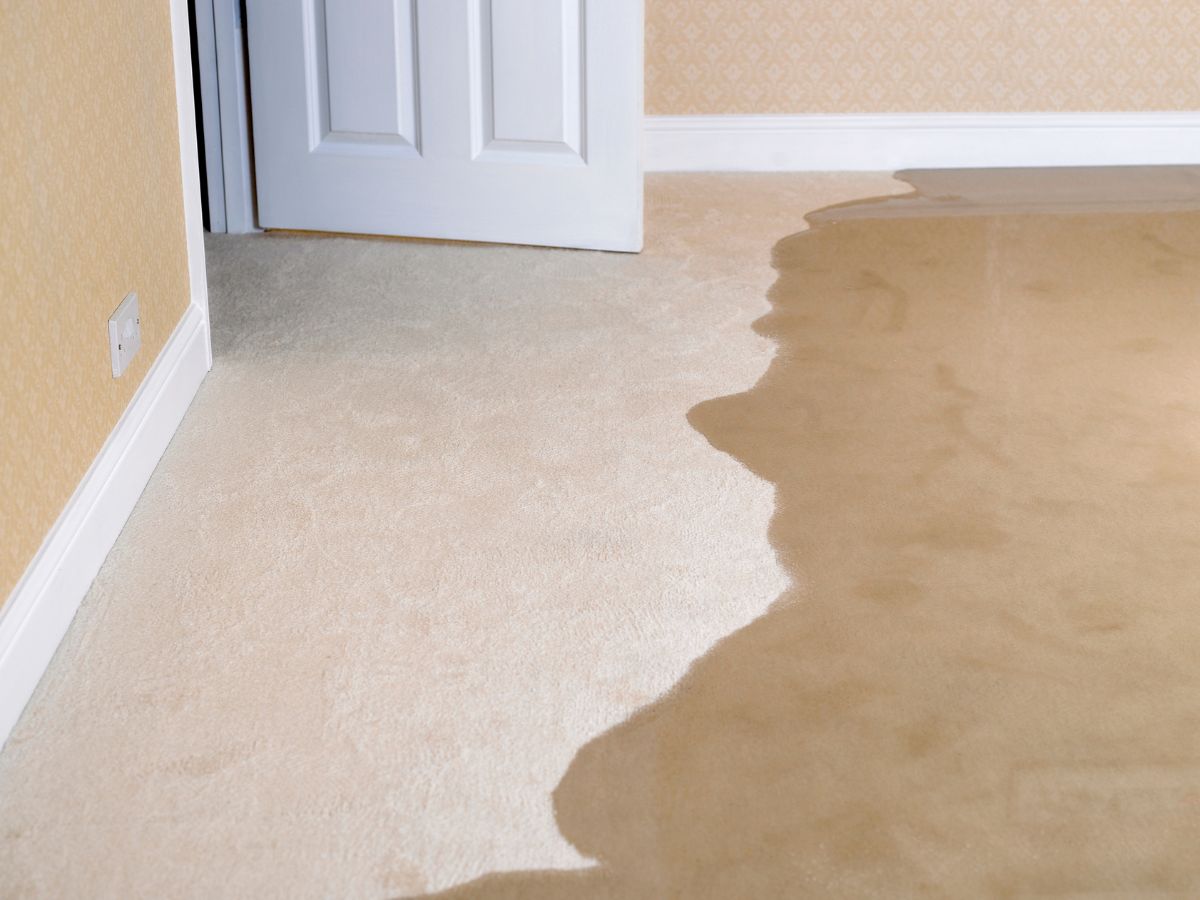
Identifying the Source of Wet Carpet Smell
Causes of Wet Carpet Odours
The unpleasant smell from a wet carpet usually comes from the fibres trapping moisture and the odours that tag along. You might find this dampness comes from various sources, like spills from food and drinks, pet accidents, or even high humidity levels in the air. These incidents leave behind a foul odour and create a perfect breeding ground for mould and mildew, especially in the padding beneath the carpet.
The growth of these fungi isn’t just a source of bad smells; it’s also a health hazard. Plus, carpets can soak up odours like smoke from the air, which, when mixed with moisture, get even more stuck in the fibres. And let’s not forget, ageing carpets can start to smell musty as the fibres break down over time.
Finding Hidden Moisture in Carpets
Detecting hidden moisture in carpets is key to tackling the root cause of that wet carpet smell. Sometimes, you won’t immediately see where the moisture is coming from—it could be an underground source or a slow leak that’s been flying under the radar. The concrete slab under the carpet can soak up water from different places, which then evaporates into the carpet underlayment, encouraging mould or mildew to grow.
To spot these sneaky damp spots, you can use a handheld concrete moisture metre to find areas with high moisture. For a thorough check, an in-situ relative humidity (RH) test is the way to go, especially in spots where the surface metre shows the highest moisture levels.
Assessing the Extent of Water Damage
To effectively fix water damage, you’ve got to know how bad it is. Signs like discoloration, warping, or wrinkling of the carpet often mean that the carpet’s been wet for a while. Peeling back the carpet to look at the damage underneath and checking the surrounding baseboards can show you how far the problem has spread.
If a carpet’s been wet for over 72 hours, mould’s probably started to grow, and you’ll need to act fast. It’s crucial to soak up any standing water quickly to prevent more damage. But if the damage is widespread or you don’t sort out the moisture source, the problem might come back or get worse in other parts of your home.
In these situations, it’s best to call in the pros to make sure the underlying issues are taken care of. This helps prevent future headaches and extra costs. Visit our emergency water damage restoration service here.
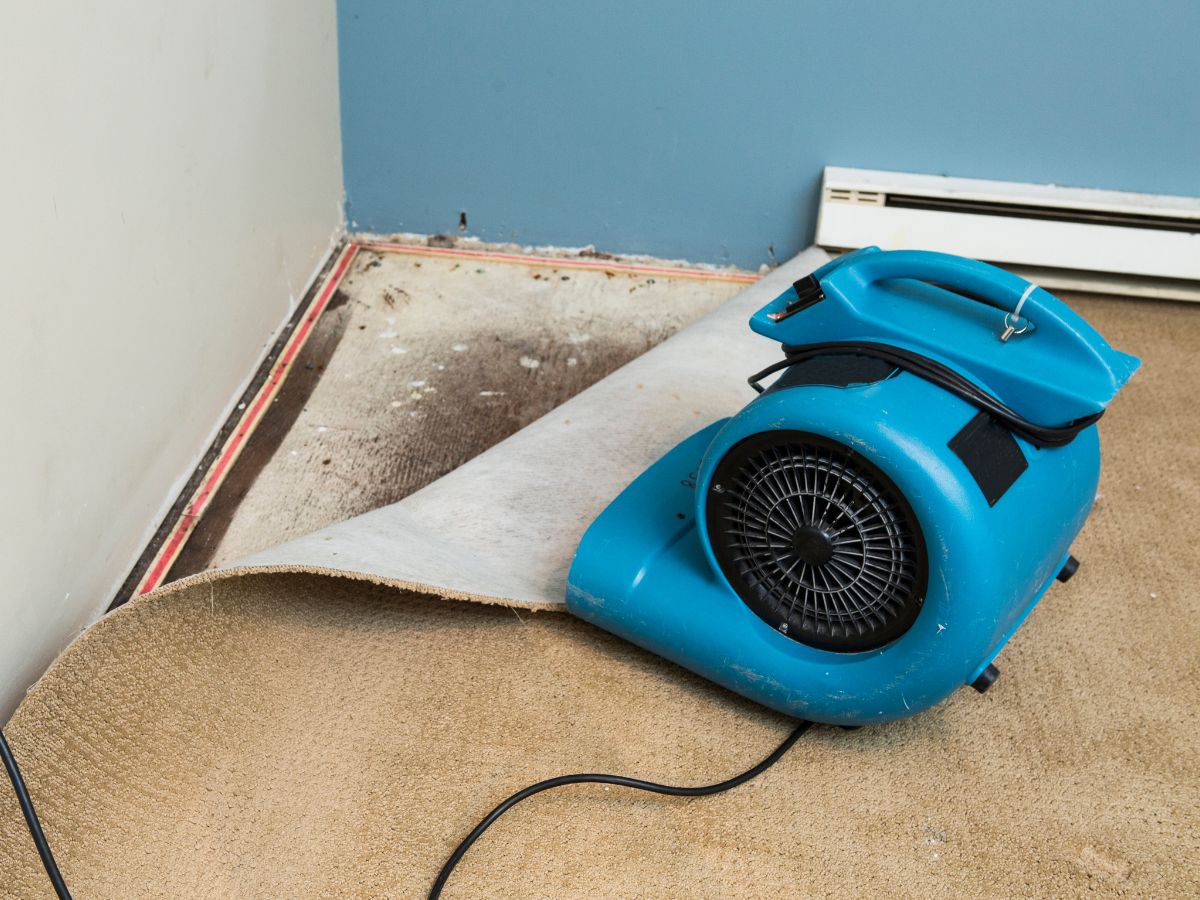
Immediate Actions to Reduce Odour
Removing Surface Moisture
Upon discovering a damp carpet, promptly address the surface moisture. Begin by laying towels over the affected area and stepping on them to help absorb the water. As the towels become saturated, wring them out and continue the process with fresh, dry towels until they no longer absorb moisture.
For a more thorough job, a wet-dry vacuum can be employed to extract water from the carpet. Pass over the area multiple times with the vacuum until no more water is being collected in the tank, indicating that you’ve removed the bulk of the moisture. Avoid using a standard vacuum cleaner for this task, as it’s not designed for wet conditions and poses a risk of damage or injury.
Ventilating the Affected Area
Enhancing air circulation is crucial for mitigating persistent damp odours. Stagnant air hinders evaporation, allowing moisture to persist. To expedite the drying process, maximise airflow by opening windows and using fans to direct air across the damp carpet, which also discourages the growth of mould and mildew.
Introducing fresh air not only addresses the immediate moisture issue but also safeguards the health of occupants and the integrity of your home, reducing the likelihood of enduring damage.
Using Dehumidifiers and Fans
In addition to natural ventilation, employing dehumidifiers and fans can significantly aid in drying out damp carpets. Dehumidifiers reduce air moisture levels, which facilitates the removal of moisture from the carpet.
Position the dehumidifier centrally in the room, ensuring it has ample space for air circulation, and operate it continuously with the room sealed off. In a 25 square metre space, this could expedite drying within approximately 12 hours. Fans further enhance air movement and evaporation. If the padding is also damp, it may be necessary to lift part of the carpet to allow air to reach the underlay.
Exercise caution when operating electrical devices in damp conditions to avoid accidents.
Applying Baking Soda for Absorption
Baking soda serves as an effective natural deodorizer and desiccant. Liberally dust baking soda over the damp area and leave it for a minimum of 30 minutes.
The baking soda will absorb residual moisture and neutralise lingering odours. Once the time has elapsed, vacuum the baking soda to reveal a more pleasant-smelling and drier carpet.
This simple method is an additional tool in your arsenal for combating wet carpet odours and is most effective when combined with other drying strategies.
Deep Cleaning Techniques
Vacuuming with a Wet/Dry Vacuum
A wet/dry vacuum is ideal for addressing spills and residual cleaning fluids. Begin by removing solid debris in the dry state. Pre-treat any stains with a carpet stain remover before using the vacuum. Apply your cleaning solution separately, then suction the moisture, ensuring you cover each area thoroughly. Overlapping strokes are essential to avoid missing any sections, and some areas may require additional drying time.
Steam Cleaning for Odour Removal
Steam cleaning effectively eliminates odours, with chlorine dioxide often used in products to target organic molecules responsible for unpleasant smells. Utilising products like Room Shocker can also address other organic odours throughout your home. For persistent issues such as pet urine or mustiness, a combination of Liquid Shocker and Room Shocker can be particularly effective.
The Role of Vinegar and Water Solution
For a fresh stain, quickly blotting with a towel is crucial. After absorbing as much of the spill as possible, apply a solution of equal parts vinegar and water, allowing it to penetrate for a few minutes. Then, use a clean towel to blot the solution. To leave a pleasant scent post-cleaning, consider adding a few drops of essential oil to the area.
Employing Professional Carpet Cleaning Services
Professional carpet cleaning services offer advanced cleaning and sanitising capabilities that surpass home methods. They use specialised equipment and products that can restore your carpet’s appearance and colour while avoiding residue. Regular professional cleaning can maintain a healthy home environment and may be required to uphold your carpet’s warranty.
Prompt professional intervention is crucial in cases of water damage to prevent the growth of black mould. Signs of water damage, such as peeling laminate floors or a musty odour, necessitate immediate expert assistance. Professional equipment can detect hidden moisture, ensuring thorough drying and reducing the risk of mould.
You can request a quote for water damage repair here.
Preventative Measures for Carpet Care
Maintaining your carpet in prime condition involves proactive strategies to ward off dirt, bacteria, and spills, which are common culprits of those unwanted carpet odours. By adhering to consistent maintenance routines and knowing how to manage accidents promptly, you’ll not only prolong the lifespan of your carpet but also maintain its freshness.
Regular Carpet Maintenance Tips
A cornerstone of carpet care is a consistent maintenance routine. Employing a high-suction vacuum cleaner is essential for eliminating dust, dirt, and potential allergens from the carpet fibres. Frequent vacuuming, particularly in areas with heavy foot traffic, is necessary to prevent the accumulation of debris that can cause odours.
Scheduling a professional carpet cleaning service biennially, using methods such as hot water extraction, can remove ingrained dirt and refresh your carpet. To prevent lasting indentations from furniture, it’s advisable to occasionally reposition heavy items. Techniques such as using a coin edge to gently lift the fibres or applying an ice cube can help restore the carpet’s pile.
For snags and sprouts, snipping them with scissors is preferable to pulling to avoid further damage. For pet owners, using a squeegee on short-fibre carpets can be an effective way to collect pet hair before vacuuming.
Placing mats at entrances can minimise the ingress of dirt. Using blinds or curtains can shield carpets from the sun’s rays that may cause discolouration.
Proper Spill Cleanup Procedures
Immediate action is essential when spills occur to avert stains and odours. For solid spills, use a dull knife or spoon for removal. For liquid spills, a towel should be used for blotting.
Rinsing with water and blotting may be necessary to diminish the stain, and this process may need to be repeated. For more stubborn stains, a diluted white vinegar solution can be applied to break down oily components. Afterwards, a weighted towel can be placed on the area to absorb residual moisture.
The Importance of Air Flow and Regular Ventilation
Ensuring adequate ventilation is crucial in preventing the damp odours associated with mould and mildew. Promoting air circulation with open windows, fans, or air purifiers can help in drying out carpets and preventing bacterial growth, which is particularly vital in humid climates.
Certain houseplants can also contribute to air purification by absorbing toxins and aiding in odour control.
Recommendations for Waterproof Padding
Selecting appropriate carpet padding can significantly impact the durability and odour resistance of your carpet. Pads with a moisture barrier can prevent liquids from reaching the subfloor, an advantage for pet owners who may face urine accidents.
Nevertheless, it’s important to note that while such padding can prevent moisture from penetrating from above, it does not offer protection against flooding. In flood scenarios, water can infiltrate from the sides or underneath, necessitating the removal of the padding to prevent trapped moisture and potential odour issues.
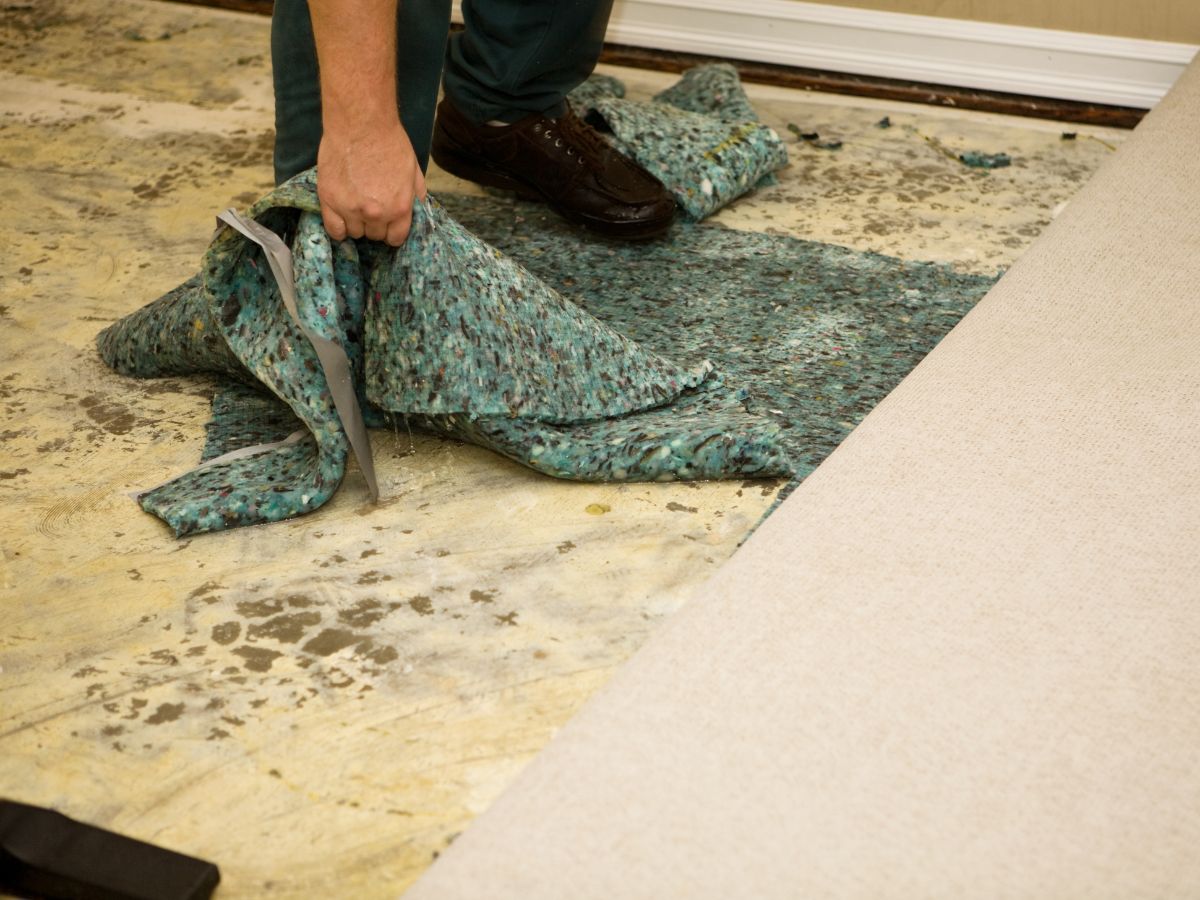
When to Consider Replacement
Signs of Irreversible Carpet Damage
Biological substances like pet urine, faeces, and vomit can usually be cleaned up quickly with little lasting effect. But if these messes are not addressed promptly, they can penetrate the carpet padding and foster the growth of mould and mildew.
It’s particularly concerning when the damage affects multiple areas. If cleaning efforts fail to eliminate persistent smells, it suggests that the odour has penetrated beyond the carpet fibres, potentially into the padding or subfloor.
Visible signs of wear in the carpet padding, such as unevenness or a crinkling sound underfoot, indicate that replacement of both the carpet and its underlayment might be necessary.
Health Risks Associated with Mould and Mildew
Exposure to mould and mildew can lead to respiratory issues, including shortness of breath, coughing, headaches, and fatigue. For allergy sufferers, older carpets can exacerbate allergic reactions. Prompt action is essential when mould or mildew is detected to safeguard health and property.
Evaluating the Costs: Clean or Replace
Determining whether to clean or replace a carpet involves considering the long-term financial implications. While professional cleaning can remove surface odours and stains, it may not address issues within the padding or subfloor. In cases where biological stains have deeply infiltrated these areas, or if the carpet has sustained extensive water damage, replacement may be more cost-effective.
Choosing the Right Materials for New Carpeting
Selecting materials for a new carpet involves balancing aesthetics with practical considerations such as durability, maintenance, and resistance to stains and moisture. Factors like the presence of pets or individuals with allergies should influence the choice to ensure the new carpet contributes to a healthier and more comfortable living environment.
Freshness Restored
Don’t let the miasma of moist carpet odours dampen your spirits or your living space. Armed with these insights and strategies, you’re well on the path to reclaiming the freshness of your floors. From quick home remedies to the wise call for professional expertise, every step is crucial in evicting unwelcome smells.
Remember, timely intervention is key, and while DIY methods can patch up the present, a professional’s touch ensures a healthier future for your carpet—and your peace of mind. So, the next time your carpet takes on water or mysterious smells, take swift action, summon the specialists, and breathe easy knowing your sanctuary will soon be scent-sational once again.

